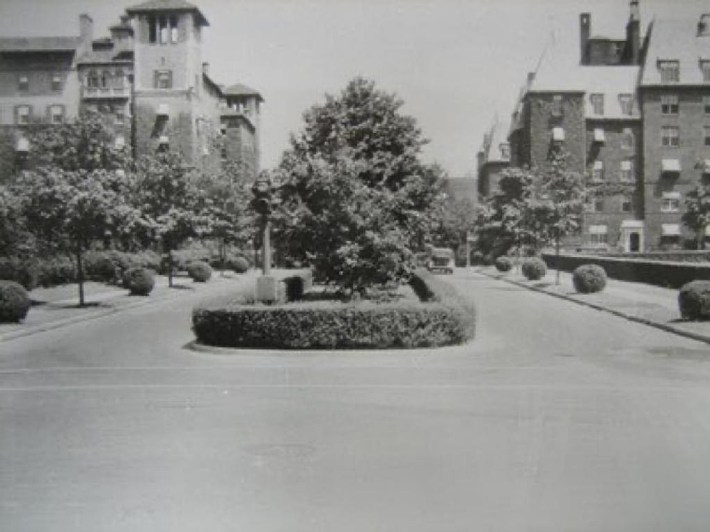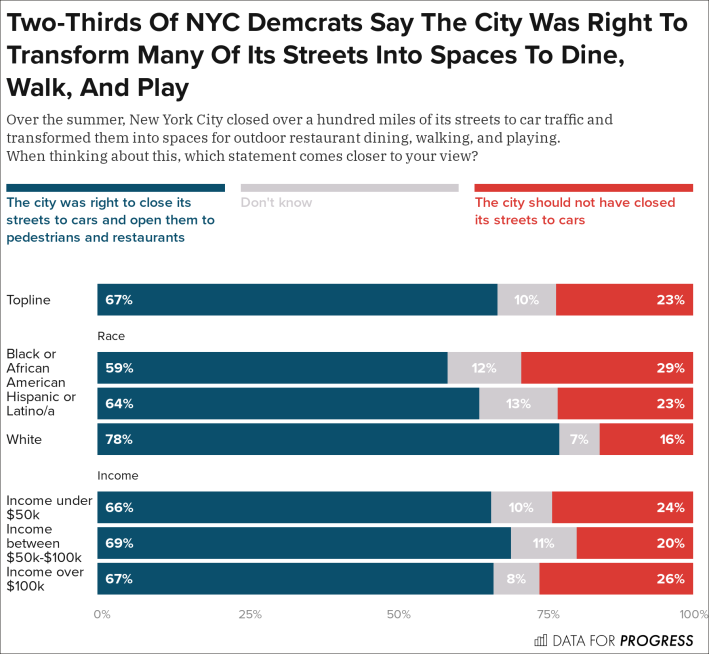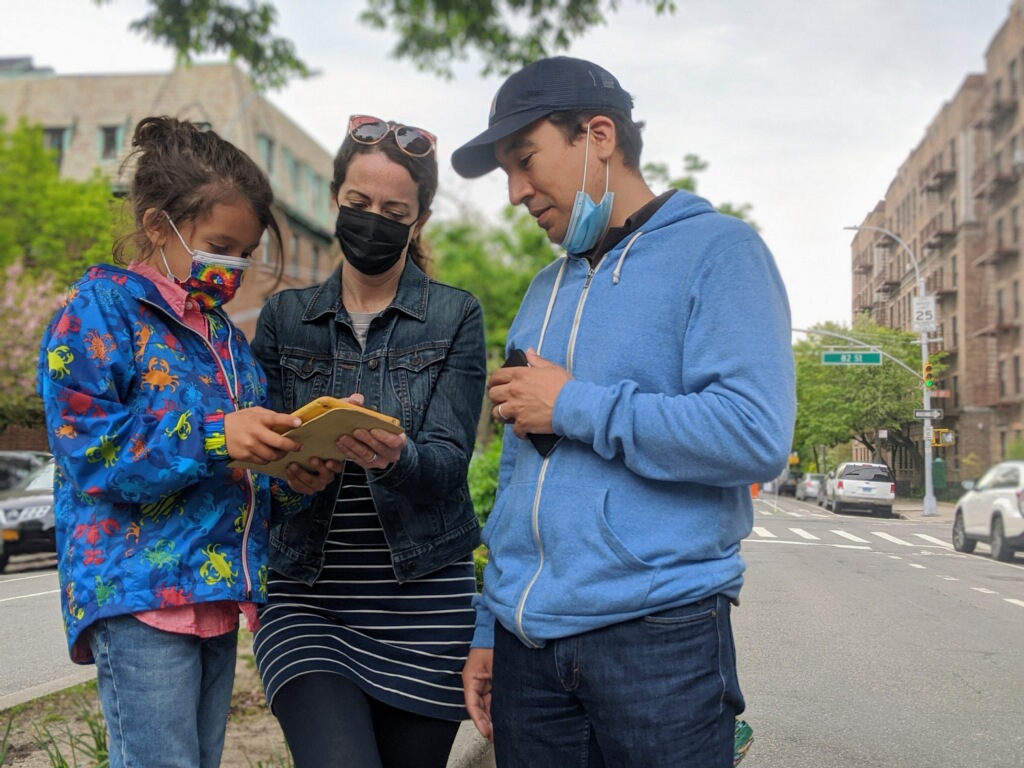Finally, there's a real compromise on the table.
Jackson Heights residents who support converting one roadway in the car-choked neighborhood into a park began collecting signatures on Sunday on a new petition designed to be the "compromise" that other groups claim they are seeking for the future of the 34th Avenue open street.
The new group, Friends of 34th Avenue Linear Park, calls for the avenue between Junction Boulevard and 69th Street to be turned into a "linear park" — but the language of the petition seems intentionally chosen to address concerns raised by opponents of the open street, which has improved neighborhood safety and quality of life.
The petition reads:
We support:
- creating the maximum amount of new green space
- maximizing safety
- providing access to existing driveways and garages
- facilitating access for emergency vehicles, delivery, city services, and school buses
- accommodating people with disabilities, including Access-A-Ride
- expanding space for public schools to use for programs
- reducing conflict between pedestrians, cyclists, and motorists
"Together, we can seize this once-in-a-lifetime opportunity to create open space and parkland for our community," it concludes.
That language is a far cry from how opponents of the open street are seeking to define supporters — with one Jackson Heights resident likening them to "Nazis" in a private Facebook post seen by Streetsblog. The main public-facing opposition page, dubbed "34th Avenue Open Streets Compromise," doesn't have a vision in its petition, except to make inaccurate claims and to contend that the majority of the neighborhood is being ignored by the Department of Transportation as it ponders what do to with the open streets program.
"A majority of the 34th Avenue residents have not been asked for their feedback," the group's post claims, despite multiple public planning sessions as well as several meetings held by the DOT with opposition groups, as Streetsblog has reported. Opposition groups have crowed on their own Facebook page of constructive meetings with Queens DOT officials, Jason Banrey and John O'Neill.
“I just had a wonderful meeting with Jason [Banrey] and John [O’Neill] from DOT,” one member of an anti-open street Facebook group posted the other day, defying claims that the opponents of street safety are not being heard by the de Blasio administration. “Jason and John are listening and open to assist us in conveying our message. … 34 OS is not a done deal as it is now, 12 hours a day, seven days a week. Jason and John are working with us believe it or not and they are our voices.”
Another petition by open streets opponents also claims to be a "compromise," but it seeks to have the open street "be discontinued or revised with shorter hours of operation," and does not address the concept that the current open street — one roadway in a neighborhood where drivers have access to every roadway all the time — is itself a compromise.
In fact, it represents the existing half-day thru traffic restrictions as a problem to be eliminated.
"The fumes and honking horns, along with the other noise and increase in litter, have made our once-beautiful neighborhood unbearable," the petition claims. It also makes a particularly ironic criticism of the open street — that a car-free roadway is antithetical to beauty and history (the car was not a part of urban life until the 1900s — and cars were not allowed to be stored on the street until the 1950s). It continues:
"Ebenezer Howard, creator of the Garden City concept, made clear that parks and commercial areas are the core of a community and acknowledged that cars were an integral part of the concept," this petition says. "34th Avenue was designed by the Queensboro Corporation as a vehicular thoroughfare. This is history, and we are prevailing on the NYC DOT to stop taking steps to permanently destroy the smooth functioning and pleasant atmosphere of our Garden City."
The passage above actually makes a case for a permanent, park-like open street, not against it. Howard, 1850-1928, did indeed create a "Garden City" concept as a response to the Industrial Age — the idea was that residents would live harmoniously with nature. But he also worked in the era before widespread car ownership destroyed cities.
"In 'Garden Cities of To-morrow,' Howard provided an outline of a garden city that promised a clean environment, free from air and water pollution, and an abundance of parks and open spaces," wrote University of Oregon academic Brett Clark.
In the end, Howard "Garden City" was a model for the suburbs, not the city — an irony, given that some opponents of the open street have told supporters that if they like open space so much, they should move to the suburbs.
And one more thing: This is what the Jackson Heights version of a Howardian "Garden City" looked like before thousands of people bought cars and then convinced elected officials to allow them to store their private property in the public right of way (which led to more car purchases):

It is unclear what DOT will do (the agency did not respond to a request for comment). Both Council Member Danny Dromm and State Sen. Jessica Ramos have told Streetsblog several times that they are expecting a design from the DOT for its proposal for a permanent open street on 34th Avenue — though no one knows yet what the definition of "permanent" is (indeed, a two-hour-per-week open street between 77th and 78th streets timed to the weekly farmers market would be "permanent" if it happens every week forever, but it would be a tiny portion of the current 1.3-mile stretch of open street).

The linear park petition is itself a compromise with drivers, who, a new Streetsblog analysis shows, have unfettered access to 67 percent of the public roadway space in Jackson Heights, while pedestrians have about 33 percent. Some drivers say the open street removes too much space from their hegemony over the roads, but the same Streetsblog analysis found that when the open street is in operation (between 8 a.m. and 8 p.m.), pedestrians gain only 1.7 percent more public space — and only for a half a day (and car drivers can still access the open street as long as they not exceed 5 mph). More than 65 percent of the property-line-to-property-line space in dense Jackson Heights is reserved for the movement or storage of vehicles.
Transportation is now the segment of the U.S. economy with the largest carbon footprint, recently jumping ahead of energy production, which has gotten cleaner over the decades as power plants have shifted from coal to natural gas and renewables. Car drivers, however, are very slow to adapt to electric cars, which pollute less, but still have high crash rates and still contribute to congestion. The de Blasio administration has a goal of dramatically reducing New York's carbon footprint, but it has not closed any roadways to cars.
It's worth nothing that the open street has contributed to a dramatic improvement in road safety on 34th Avenue during the hours that thru traffic is banned. As Streetsblog reported, injuries dropped by 85 percent and crashes dropped by nearly 80 percent in the hours when barricades prevent thru traffic.
That has not prevented some open streets opponents from claiming to DOT that the roadway is less safe. And the fact that drivers can still access every roadway in the neighborhood has not prevented car owners from claiming that open street supporters want to block them from accessing neighborhood garages.
Council Member Dromm has said he favors a linear park (though he did not respond to a request for comment about the new petition). State Sen. Ramos has said recently that she is seeking a "compromise," but she has not defined what she means by that. (In a brief interview with Streetsblog on Sunday night, Ramos did say, "I like everything it [the petition] says.”)
The issue of what constitutes a "compromise" remains at the heart of the problem. Car drivers believe that a "compromise" means reducing the hours or days of the open street. But there are many people in Jackson Heights — hundreds of whom have already signed the new petition, according to organizers — who feel they have been compromising for years, thanks to the limited amount of public space in the neighborhood (among the lowest per capita in the city). To them, the existing open street is a tiny gain, but it certainly does not even come close to a compromise by car drivers and their advocates.
"Our petition addresses everyone's concerns, but it is also the vision and the dream," said Dawn Siff, who was a member of the group that collected signatures on Sunday.
"Tens of thousands of people are using this open street every day and they aren't even aware that some people want to take it away from them!" she added. "This is an incredible, once-in-a-lifetime opportunity to formally turn this space into a neighborhood treasure. If we don't do this, I will feel like I have failed my children."
Siff urged the mayor to visit 34th Avenue himself, something he has not done, despite creating the open streets program. DOT officials have referred to 34th Avenue as "the gold standard" of open streets.
"Mayor de Blasio should come out and see what a joy his program has given our diverse community," Siff said. "Making it into a permanent park would cement his legacy."
And a popular one: In a survey of 591 registered voters commissioned by Open Plans, the national polling firm Data for Progress found that 67 percent of New Yorkers think the city “was right to close its streets to cars and open them to pedestrians and restaurants.” (See chart below.)

In another question, 72 percent of respondents said they prefer “livable streets that prioritize people’s needs and their safety” to 22 percent that said they prefer “streets that prioritize traffic and parking.”






